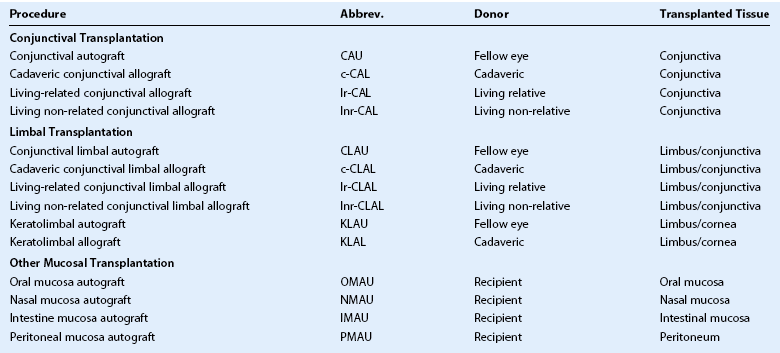The Classification of Ocular Surface Transplantation
Introduction
The ocular surface of the eye is a complex functional unit consisting of several elements that all interrelate. These include the eyelids, lubrication, conjunctiva and cornea. Homeostasis of the ocular surface is vital for the maintenance of good corneal epithelium, which in turn ensures good corneal clarity and vision. Lids provide protection to the ocular surface, as well as distribution of tears through a wiper-type action picking up tears from the lower lid meniscus and distributing this across the corneal surface. Lubrication is important in terms of content, osmolality and quantity.1 Normal conjunctiva provides mucins from goblet cells along with cytokines and the corneal limbus has been recognized and accepted as the source of limbal stem cells for the replacement of normal corneal phenotype.2–3
Numerous techniques to rehabilitate the ocular surface have developed over the last two decades. Rehabilitation of the ocular surface includes improving the ocular surface environment and, in particular, ensuring control of inflammation, good lubrication, lid closure and elimination of keratinization and symblephara. Restoration of the normal corneal phenotype and appropriate corneal clarity is highly dependent on a good environment.4 A number of transplantation techniques have been employed over the years, and many have been described with various terminology, including autologous and allograft conjunctival transplantation,5–7 keratoepithelioplasty,8 homotransplantation of limbal cells,9 limbal transplantation,10 and autologous11 and allograft limbal transplantation.12–15 These terms are not always clear in terms of tissue source (auto- or allogeneic) and precise anatomic location. Limbal transplantation, for instance, can be conjunctival alone or corneoscleral.16 Additionally, in the last 15 years tissue engineered techniques have become more popular and include culture and expansion of presumed stem cells and transplantation back to the host or to another recipient.17–27
Clarity of communication is necessary as is the ability to accurately compare outcomes of these innovative procedures. Holland and Schwartz, recognizing the need for common terminology, provided a rationale for common nomenclature illustrating a variety of techniques described in the literature, often using similar terminology.16 The authors proposed a classification based on: (1) anatomic source of the tissue and (2) genetic source (autologous, allogeneic and living related). Since the publication in1996, further developments have resulted in the description of more techniques, as well as new sources of tissue28–35 along with the introduction of cell culture techniques.36–44 In order to include all current techniques and procedures, the Cornea Society felt there was a need for an internationally agreed nomenclature. This nomenclature was established by an international group of cornea surgeons involved in ocular surface transplantation through an initial steering committee (Table 39.1) and once ratified by the Board of the Cornea Society was published in Cornea.45 A literature search was performed to ascertain types of ocular surface rehabilitative procedures reported for which inclusion in the new nomenclature. The committee agreed to expand on the principles initially proposed by Holland and Schwartz in 1996.16 The nomenclature was based on the following criteria: (1) anatomic source of the tissue being transplanted, (2) genetic source – autologous or allogeneic and to reflect histocompatability in the latter group, whether living-related or not, and (3) cell culture techniques. Types of procedures were broadly categorized by the anatomic type, source, and whether it was tissue engineered (Box 39.1). Further categorization according to anatomic type of tissue, namely conjunctival, limbal and other mucosal grafts is listed in Table 39.2. Tissue engineered procedures are listed in Table 39.3 and classified according to anatomic source of tissue.
Anatomic Type
The principle anatomic sources of tissue for ocular surface rehabilitative procedures are either conjunctiva or limbus. The use of peritonea46–48 and rectal mucosa28 as sources of cells have been described, requiring the inclusion of a third category of ‘other mucosal’ tissue. Conjunctival tissue is increasingly recognized as an important contributor to the welfare of the ocular surface and felt to be necessary in cases where there is concomitant conjunctival deficiency.49 The provision of mucins from goblet cells, as well as cytokines, contributes to the milieu and equilibrium of the ocular surface. Conjunctival tissue is not to be confused with limbal conjunctival tissue and is confined to bulbar and forniceal conjunctiva only. There have been reports suggesting the fornix as a source of conjunctival stem cells and there may be some theoretical advantage of using fornix over bulbar conjunctiva; however, as this has not been demonstrated scientifically, the committee chose not to further classify the source of conjunctiva.50
Other mucosal tissue, including buccal,29,30 nasal,33










